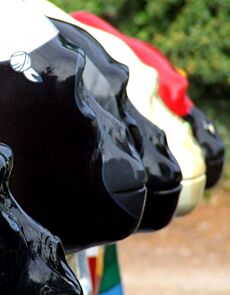Paignton Zoo facts for kids
 |
|
| Date opened | 1923 |
|---|---|
| Location | Paignton, Devon, England |
| Land area | 80 acres (32 ha) |
| Coordinates | 50°25′44″N 3°35′4″W / 50.42889°N 3.58444°W |
| No. of animals | Over 2,000 |
| No. of species | Over 250 |
| Major exhibits | Reptile Tropics, Crocodile Swamp, Ape Centre, Lemur Wood, Monkey Heights |
Paignton Zoo is a famous zoo located in Paignton, Devon, England. It started as a private collection of animals owned by Herbert Whitley in 1923. His home, Primley House, was where it all began. Over the years, the zoo has grown a lot.
Today, Paignton Zoo is home to about 2,000 animals from nearly 300 different species. It also cares for over 1,600 types of plants! The zoo is run by the Wild Planet Trust, which works hard to protect wildlife.
Contents
History of Paignton Zoo
How the Zoo Began
Herbert Whitley loved collecting and breeding animals from a young age. He inherited a lot of money and used it to follow his passion. He moved to Devon and started breeding many kinds of animals, especially focusing on creating blue animals.
His home, Primley House, became filled with all sorts of creatures. He even had a chimpanzee named Bonny Mary, who was famous for being very clever!
First Time Open to the Public
In July 1923, Herbert Whitley decided to open his animal collection to the public. He called it Primley Zoological Gardens. People could visit for a small fee.
However, tax officials soon told Herbert he needed to charge an "amusement tax" on tickets. Herbert disagreed, saying his zoo was for education, not just entertainment. He lost the court case and immediately closed the zoo in protest. He even put up signs explaining why he closed it!
Reopening and Another Closure
Herbert reopened the zoo in 1927, agreeing to pay the tax. But in 1934, he opened a new "Tropical House" and charged an extra fee. The tax officials wanted tax on this new fee too. Herbert refused again, lost in court, and closed the zoo for a second time.
Animals During World War II
Even when the zoo was closed, Herbert kept collecting animals. During World War II, Chessington Zoo needed a safe place for their animals. Herbert agreed to house them at Primley. This meant Paignton suddenly had many more animals, including lions and tigers! A miniature railway and even circus performers from Chessington also came to Paignton.
The zoo was then run as Devon's Zoo and Circus, focusing more on entertainment. After the war, most of the Chessington animals went back home, but the circus stayed until 1953, and the miniature railway ran until 2022.
Becoming a Trust
When Herbert Whitley passed away in 1955, a special group called the Herbert Whitley Trust was created to continue his work. This trust is now known as the Wild Planet Trust. This trust also manages Newquay Zoo and used to run Living Coasts.
Growing as a Conservation Center
The zoo continued to grow. In 1961, it hired its first full-time education officer to teach visitors about animals. More exotic animals arrived, like giraffes in 1968 and orangutans in 1993.
In the late 1990s, the zoo received a lot of money to build new and improved areas. This included the Marie Le Fevre ape center and the Reptile Tropics attraction.
Paignton Zoo in the 21st Century

In 2003, the trust expanded by buying Newquay Zoo and building Living Coasts. The zoo also held fun charity events like the Great Gorilla Project in 2013 and the Great Big Rhino Project in 2016, raising lots of money for conservation.
In 2019, Duchess, the zoo's only African Elephant, passed away. The miniature railway, a reminder of the Chessington animals, closed in 2022.
Animals at Paignton Zoo
Paignton Zoo is home to about 2,000 animals from over 400 different species. These include mammals, birds, reptiles, and amphibians. The animals live in areas designed to look like their natural homes.
- Mammals
- African lion
- African pygmy mouse
- African pygmy goat
- Azara's agouti
- Black howler
- Bornean orangutan
- Brazilian guinea pig
- Brown spider monkey
- Celebes crested macaque
- Cheetah
- Cherry-crowned mangabey
- Collared peccary
- Common dwarf mongoose
- Common squirrel monkey
- Cotton-top tamarin
- Diana monkey
- Eastern bongo
- Eastern black rhinoceros
- Emperor tamarin
- Goeldi's marmoset
- Hamadryas baboon
- Hartmann's mountain zebra
- King colobus
- Kirk's dik-dik
- Lar gibbon
- Mandrill
- Maned wolf
- Meerkat
- Mishmi takin
- Ouessant sheep
- Pied tamarin
- Pileated gibbon
- Pygmy marmoset
- Pygmy slow loris
- Red-fronted lemur
- Red panda
- Red river hog
- Red ruffed lemur
- Ring-tailed lemur
- Rothschild's giraffe
- Short-beaked echidna
- South American tapir
- Southern three-banded armadillo
- Sumatran tiger
- Swamp wallaby
- Western grey kangaroo
- Western lowland gorilla
- Birds
- Black hornbill
- Bourke's parrot
- Brown eared pheasant
- Budgerigar
- Chilean flamingo
- Eclectus parrot
- Edwards's pheasant
- Emu
- Great argus
- Greater roadrunner
- Grey crowned crane
- Hamerkop
- Marabou stork
- Nene
- North Island brown kiwi
- Oriental stork
- Pink pigeon
- Princess parrot
- Red-crowned crane
- Red-necked ostrich
- Roseate spoonbill
- Scarlet ibis
- Secretarybird
- Socorro dove
- Southern cassowary
- Southern screamer
- Spectacled owl
- Sumatran laughingthrush
- Toco toucan
- Wattled crane
- White-faced whistling duck
- Wrinkled hornbill
- Herps
- Aldabra giant tortoise
- Annam leaf turtle
- Blue tree monitor
- Boyd's forest dragon
- Chinese crocodile lizard
- Common flat-tail gecko
- Cuban crocodile
- Emerald tree boa
- False gharial
- Fea's tree frog
- Komodo dragon
- Lesser Antillean iguana
- Mangrove monitor
- Nguru pygmy chameleon
- Northern caiman lizard
- Red-eyed tree frog
- Red-footed tortoise
- Red-tailed ratsnake
- Reticulated python
- Saltwater crocodile
- Solomon Islands skink
- Yellow-banded poison dart frog
- Yellow-headed water monitor
Incidents and Escapes
Over the years, Paignton Zoo has had a few animal escapes and interesting incidents.
In 1939, a leopard got out of its home but stayed on zoo grounds. It was eventually shot to keep everyone safe. In 1946, a grass monkey went missing but returned to its cage on its own.
A zookeeper was hurt by a North American brown bear in 1948. In 1954, a large black-necked stork flew away and was found two weeks later far from the zoo.
In 1956, four boa constrictors escaped but were found nearby. In 1959 and 1964, wallabies escaped after wires were cut by intruders. Some were quickly found, but one wallaby stayed free for over two weeks!
In 1961, a loud noise caused a zebra to escape into nearby woods, and a tapir also got out but was found quickly. The biggest escape was in 1964 when Jumbo, an Indian elephant, was free for over six hours on zoo grounds. People were told to stay indoors as a precaution.
More recently, in 2005, a wild pig called a peccary escaped into public areas, leading to visitors being kept safe inside buildings. In 2017, three western lowland gorillas got into a secure corridor and caused some damage overnight.
In September 2022, the zoo had to close due to bird flu. On the first day it reopened, two lar gibbons escaped, causing the zoo to be evacuated. They were safely recaptured. In August 2023, visitors were again kept indoors when a monkey escaped its enclosure.
Conservation Efforts
Paignton Zoo is a big part of protecting animals and plants. It belongs to important groups like the British and Irish Association of Zoos and Aquariums (BIAZA) and the World Association of Zoos and Aquariums (WAZA).
The zoo works with other zoos and gardens around the world. They manage special breeding programs to help save endangered species. They also work on plant conservation.
Education and Research
The zoo has a large team dedicated to education. They teach about 50,000 students each year, from young children to older students. They also work with adult groups.
The zoo also has a science department that started in 1997. Now called the Field Conservation and Research Department, it's one of the best in Europe. Staff work on projects at the zoo, at other Wild Planet Trust sites, and even overseas. They do research at different levels of study.
Botanical Gardens
Paignton Zoo is not just about animals; it's also a fantastic botanical garden! It has many different types of trees, shrubs, and plants from various habitats.
Inside the special growing areas, the zoo can grow plants from all over the world. You can see tiny, rare cactus plants in the desert house. There are also huge plants like the Titan arum, giant bamboo, and giant water lilies in the tropical houses.
Awards and Recognition
Paignton Zoo has received several awards and been recognized as a top zoo.
In 2014, based on visitor reviews, TripAdvisor named it the third best zoo in the UK and the ninth best in Europe. In 2015, The Independent newspaper listed Paignton as one of the top 10 zoos in the UK.
The Camping and Caravanning Club also includes Paignton Zoo on its list of the 15 "best and biggest" zoos in the UK.
Television Appearances
Paignton Zoo has been featured in several television shows.
In 1998, the BBC One series Zoo Keepers followed the daily lives of the zoo staff for two seasons.
ITV Westcountry filmed a documentary called Zoo Story in 2004, which was narrated by Ruth Langsford. A book based on the series was also published.
In 2017, the children's TV channel CBBC created The Zoo. This was a comedy show filmed at Paignton Zoo from the animals' point of view. It aired for two seasons, with each episode lasting about 14 minutes.
Images for kids








